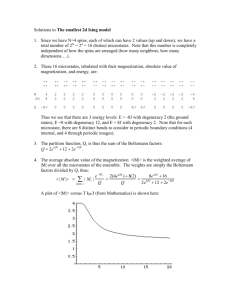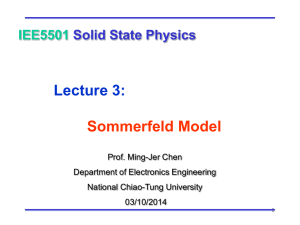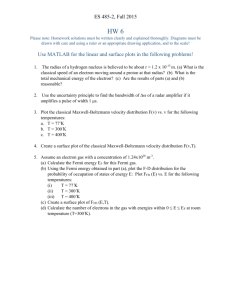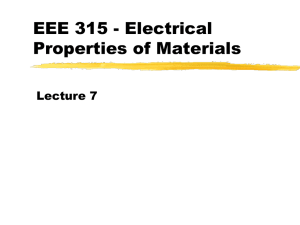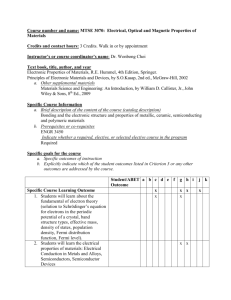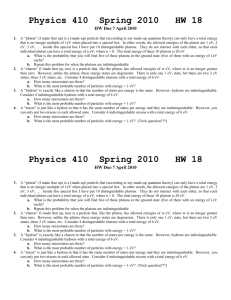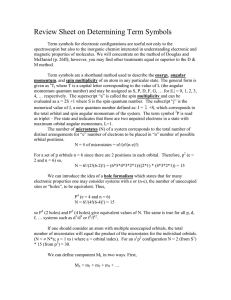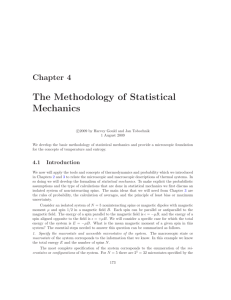SOLVED EXAMPLES Distribute three particles in two different states
advertisement
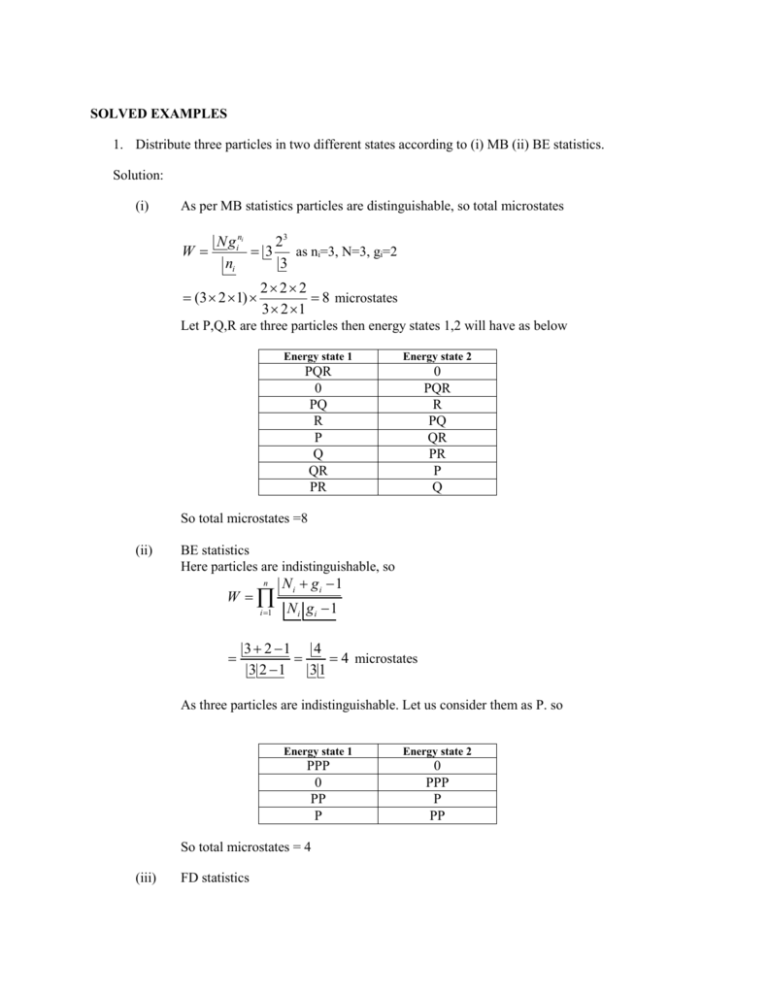
SOLVED EXAMPLES 1. Distribute three particles in two different states according to (i) MB (ii) BE statistics. Solution: (i) As per MB statistics particles are distinguishable, so total microstates Ngini 23 as ni=3, N=3, gi=2 W 3 ni 3 (3 2 1) 2 2 2 8 microstates 3 2 1 Let P,Q,R are three particles then energy states 1,2 will have as below Energy state 1 Energy state 2 PQR 0 PQ R P Q QR PR 0 PQR R PQ QR PR P Q So total microstates =8 (ii) BE statistics Here particles are indistinguishable, so n N i gi 1 i 1 N i gi 1 W 3 2 1 4 4 microstates 3 2 1 31 As three particles are indistinguishable. Let us consider them as P. so Energy state 1 Energy state 2 PPP 0 PP P 0 PPP P PP So total microstates = 4 (iii) FD statistics Here particles are indistinguishable and obey Pauli’s exclusion principle W gi ni gi ni 2 ve which is not possible. So FD statistics can not be 3 23 applied on these particles. 2. Three distinguishable particles each of which can be accommodated in energy states E, 2E, 3E. 4E with total energy 6E. Find all the possible number of distributions. Also find total microstates in each case. (WBUT-2007). Solution: Suppose three particles are P,Q,R and distinguishable. Possible Arrangements 2,0,01 0,3,0,0 1,1,1,0 E 2E 3E 4E PQ PR QR 0 P Q R Q R P 0 0 0 PQR Q P P R Q R 0 0 0 0 R R Q P P Q R Q P 0 0 0 0 0 0 0 Total Energy 6E 6E 6E 6E 6E 6E 6E 6E 6E 6E Total Microstates 3 1 6 Hence total arrangements = Macrostates = 3 And total microstates = 10 3. A system with non-degenerate single particle state with 0,1,2,3 energy units. Three particles are to be distributed in three states so that the total energy of the system is 3 units. Find the number of microstates if particles obey (i) MB statistics (ii) FD statistics. (WBUT 2008). Solution: Let the particles be P,Q,R which are distinguishable. So for (i) MB statistics Macrostates 0E 1E 2E 3E 0,3,0,0 2,0,0,1 0 PQ PR QR P Q R PQR 0 0 0 Q P P 0 0 0 0 R R Q 0 R Q P 0 0 0 1,1,1,0 Total Energy 3E 3E 3E 3E 3E 3E 3E Total Microstates 1 3 6 Q R P R Q R P P Q 0 0 0 3E 3E 3E So total microstates = 10 And for (ii) BE statistics- here particles are indistinguishable. suppose there are denoted by P Macrostates 0E 1E 2E 3E 0,3,0,0 2,0,0,1 1,1,1,0 0 PP P PPP 0 P 0 0 P 0 P 0 Total Energy 3E 3E 3E Total Microstates 1 1 1 So total microstates = 3 (iv) FD statistics – here particles obey Pauli’s exclusion principle and they are indistinguishable. So Macrostates 0E 1E 2E 3E Total Total Energy Microstates 1,1,1,0 P P P 0 3E 1 So total microstates = 1 4. Show that at T=0, the average energy E of an electron in a metal is given by E 3 E f (0) 5 where Ef(0) is Fermi energy at absolute zero. Solution: As electron is a fermion. Total energy at absolute zero is given by U (0) E f (0) 0 1 2 EN ( E )dE f ( E ) ECE dE where C is the constant depending over other 0 properties. And at absolute zero f(E) = 1 so U (0) C E f (0) 0 So 3 2 5 E 2 dE C E f2 (0) 5 3 NE f (0) 5 3 E E f (0) 5 hence proved 5. Calculate the Fermi energy in copper. Consider density of copper as 8.94 x 103 kg/m3 with atomic mass 63.5 amu. Solution: Here electron density = N/V atom/m3 N N A 6.02 1026 8.94 103 V W 63.5 =8.48 x 1028 atoms/m3 Fermi energy E f h 3 N 2m V 2 2 1.05 10 34 2 2 9.11031 0.06 10 37 2 3 2 3 9.86 8.48 1028 3 2 27 3 2508.38 10 6.91 eV 6. Table shows the results for Fermi energies of some monovalent elements Metal Cu Li Rb Cs Ag K Ef 7.04 4.72 1.82 1.53 5.51 2.12 If the Fermi velocity of electron in one of the metals is 0.73 x 106 m/s. Identify the metal. Also calculate the Fermi temperature. Solution: At Fermi energy, Kinetic Energy = E f 1 2 mv f =0.5 x (9.1x10-31)(0.73x106)2 2 =2.42 x 10-19 joules =1.51 eV hence the metal is Cesium. And Fermi energy at Fermi temperature, E f kT f Or 2.42 1019 Tf k 1.38 1023 Ef = 1.75 x 104 K. 7. If the Fermi energy of any metal is 10 eV. What is the corresponding classical temperature? Solution: We have E 3 3 kT E f 2 5 So T 2E f 5k 2 10 1.6 1019 5 1.38 1023 =4.64 x 104 K. 8. There are about 25 x 1028 free electrons/m3 in sodium. Calculate its Fermi energy, Fermi velocity and Fermi temperature. Solution: Here N =electron density = 2.5 x 1028 /m3 V 34 h2 3N 3 6.62 10 3 3 Now Fermi energy E f 2.5 1028 31 2m 8V 2 9.110 8 2 2 2 =5 x 10-19 Joules =3.1 eV This is the maximum kinetic energy of free electron at 0 K. 1 Then 1 E f mv 2 2 And E f kT f or 1 2 E 2 2 5 1019 2 vf f 31 m 9.110 =1.047 m/s So Tf 5 1019 1.38 1023 = 3.623 x 104 K. 9. Calculate the extent of the energy range between f(E) =0.9 and f(E) = 0.1 at 200 K and express the same as a function of Ef which is 3 eV. Solution: We know that f E Ni 1 Ei E f / kT gi 1 e 1 1 e Where x (i) E f E / kT 1 1 e x Ef E kT When f(E) = 0.9 so 0.9 1 0.9e x 1 0.9 0.1 1 e x 1 or e x 9 9 So x log e 9 =2.198 e x E f E 2.198 kT 1.38 1023 200 Now kT eV 1.6 1019 =0.017 eV When f(E) = 0.1 (ii) 1 on solving x 2.3026log10 9 1 ex E1 E f 2.3026 0.954 0.017 0.1 E1 = Ef + 0.0.37 = 3 + 0.037 = 3.037 eV So ΔE=E1-E = 3.037 – 2.963 = 0.074 eV Or E 0.074 = 0.025 = 2.5% Ef 3 10. Calculate the temperature at which there is only one percent probability that a state, with energy 0.5 eV above Fermi energy will be occupied by an electron. Solution: We know that f E 1 1 e Ei E f / kT Here E – Ef = 0.5 eV and f(E) = 1% = 1/100 So 1 1 100 1 e x So ex 0.99 99 0.01 Or x 2.3026log10 99 Or T or kT 1.109 1.6 1019 = 1264 K 1.38 1023 0.5 1.109 eV 2.3026 log10 99
